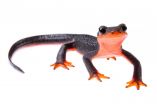(Press-News.org) Washington, DC - July 30, 2015 - In research that could lead to protective probiotics to fight the "chytrid" fungus that has been decimating amphibian populations worldwide, Jenifer Walke, PhD, a postdoctoral researcher at Virginia Tech University, Blacksburg, and her collaborators have grown bacterial species from the skin microbiome of four species of amphibians. The research appears July 10 in Applied and Environmental Microbiology, a journal of the American Society for Microbiology.
In the study, the investigators swabbed the four species, all of which inhabit Virginia. They grew, or cultured what bacteria they could from the swabs, and sequenced those cultures. They also sequenced all of the bacteria inhabiting the skin of each amphibian using next-generation sequencing. Next, they compared the cultured bacterial sequences to species which data suggests are dominant on amphibian skin.
Most of the bacteria that could be grown, or "cultured," were dominant species, although some rare species were culturable. "Dominant bacteria might be likely to contribute important functions, such as disease resistance, to their host," said Walke. "At least some species are known to produce antifungals, and we consider these to be strong candidates for amphibian probiotics."
While the investigators were unable to culture some presumptive dominant species, Walke suggests that merely tweaking culturing conditions might make it possible to grow some of these species.
The investigators were able to grow less than ten percent of the bacterial species in the amphibian skin microbiome. Moreover, "we found that amphibian species have distinct microbial communities, and this pattern held for both the cultured and the sequenced bacteria," said Walke.
"The research is important because many amphibians play critical roles in ecosystems, for example, controlling populations of harmful insects, including those that carry human diseases, such as malaria," said Walke. "Additionally, what we are learning about the role of microbes in amphibian disease resistance has applications to other species, such as white-nose syndrome in bats, and fungal disease in snakes, many of which control rodents that carry human diseases.
Amphibians include frogs, toads, salamanders, newts, and caecilians. The latter are limbless burrowing creatures of the southern hemisphere, and are not (yet) known to be infected with chytrid fungus. That fungus, Batrachochytrium dendrobatidis, is currently known to infect nearly 300 species of amphibians, and has caused around 100 extinctions, according to one estimate.
B. dendrobatidis' spread is driven largely by commercial trade in amphibians, 100 million of which are shipped annually. And now a new species of chytrid fungus is killing salamanders in Europe. "There is great concern that this species is going to arrive in America and decimate the amazingly diverse salamander communities in the eastern US," said Walke.
A total of around 6,000 species of amphibians are known, roughly one third of which are threatened or have become extinct, said Walke. The fungus was discovered in 1997, but amphibians were being decimated as early as the 1970s. Multiple factors that act synergistically--all due to human activity--threaten amphibians, including habitat destruction, infectious diseases, pollution, pesticides, climate change, invasive species, and over-harvesting for the food and pet trades. In mountainous areas, B. dendrobatidis is the single greatest threat to amphibians.
Walke said that the benefits of the research will go beyond species preservation. It will contribute to the ability to culture diverse bacterial species, which will aid in disease control generally, as well as developing renewable energy, decontaminating pollutants, and improving understanding of evolution.
INFORMATION:
This article can be found online at http://aem.asm.org/cgi/reprint/AEM.01486-15v1?ijkey=Z24E9bLQn9STg&keytype=ref&siteid=asmjournals.
The American Society for Microbiology is the largest single life science society, composed of over 39,000 scientists and health professionals. ASM's mission is to advance the microbiological sciences as a vehicle for understanding life processes and to apply and communicate this knowledge for the improvement of health and environmental and economic well-being worldwide.
PHILADELPHIA -- The importance of a diet rich in fish oils - now a billion dollar food-supplement industry -- has been debated for over half a century. A few large clinical trials have supported the idea that fish oils confer therapeutic benefits to patients with cardiovascular disease. Researchers think that hearts and blood vessels may benefit in part from their anti-inflammatory properties.
Synthetic versions of marine fish lipid-derived molecules called specialized pro-resolving mediators (SPMs) show anti-inflammatory properties in cell cultures and live animal models. ...
Not every mom and dad agree on how their offspring should behave. But in genetics as in life, parenting is about knowing when your voice needs to be heard, and the best ways of doing so. Typically, compromise reigns, and one copy of each gene is inherited from each parent so that the two contribute equally to the traits who make us who we are. Occasionally, a mechanism called genomic imprinting, first described 30 years ago, allows just one parent to be heard by completely silencing the other.
Now, researchers at the University of Utah School of Medicine report on a ...
If the technical features of a new camera delight the tech experts but leave consumers scratching their heads, how should a retailer's website present those views and what sales results could it expect?
A paper to be published in the September issue of the Journal of Retailing provides insights on the relatively new phenomenon of online user reviews.
In "User Reviews Variance, Critic Reviews Variance, and Product Sales: An Exploration of Customer Breadth and Depth Effects," Feng Wang of Hunan University, Xuefeng Liu of Loyola University Maryland, and Eric Fang of ...
A national coalition of experts that includes two University of Washington researchers has a bold plan to reduce behavioral health problems such as violence and depression among young people across the country by 20 percent in a decade.
And their proposal rests on one simple principle: prevention.
The group's paper, recently published on the National Academy of Medicine website, recommends implementing evidence-based prevention programs on a national scale to reduce a host of problems ranging from drinking to delinquent behavior, anxiety and risky driving. It notes ...
Many physicians are pushing back against or debating new requirements for maintaining medical board certifications, which affect more than 250,000 physicians nationwide. Now, a new study by UC San Francisco and Stanford University researchers concludes that the cost of implementing the most recent requirements will be an estimated $5.7 billion over the next 10 years.
In their study, published online on July 27, 2015, in the Annals of Internal Medicine, the researchers found that most costs of the latest maintenance-of-certification (MOC) requirements implemented for ...
Athens, Ga. - An international team of researchers led by scientists at the University of Georgia has discovered how parasitic plants, which steal their nutrients from another living plant, evolved the ability to detect and attack their hosts. Their findings, published recently in the journal Science, could lead to new techniques to control the thieving weeds.
There are thousands of parasitic plant species, but the most burdensome for humans are those that infiltrate farmland and destroy crops. Parasite infestations reduce crop yields by billions of dollars each year, ...
In cells with latent HIV infection, the virus is dormant, and such cells are therefore not attacked by the immune system or by standard antiretroviral therapy. To eradicate the virus from the human body and truly cure a patient, reservoirs of latently infected cells need to be activated and eliminated "the so-called "kick-and-kill" approach. Two studies published on July 30th in PLOS Pathogens report encouraging results on the use of a combination of several drugs to efficiently reactivate HIV in cells with latent infection.
Please contact plospathogens@plos.org if you ...
A deadly fungus identified in 2013 could devastate native salamander populations in North America unless U.S. officials make an immediate effort to halt salamander importation, according to an urgent new report published today in the journal Science.
San Francisco State University biologist Vance Vredenburg, his graduate student Tiffany Yap and their colleagues at the University of California, Berkeley and the University of California, Los Angeles say the southeastern United States (particularly the southern extent of the Appalachian Mountain range and its southern neighboring ...
Scientists at Columbia University's Mailman School of Public Health and the School of Public Health of Li Ka Shing Faculty of Medicine at the University of Hong Kong have shown for the first time that it is possible to predict the timing and intensity of influenza outbreaks in subtropical climates like Hong Kong where flu seasons can occur at different times and more than once during a year. Results appear online in the journal PLOS Computational Biology.
Since the 2013-2014 season, the Mailman School scientists have published weekly regional flu forecasts for over 100 ...
Worldwide, influenza kills an estimated 250,000 to 500,000 people each year. A new study publishing in PLOS Computational Biology has shown that for the first time it is possible to predict the timing and intensity of influenza outbreaks in subtropical climates, such as Hong Kong, where flu seasons can occur at irregular intervals year-round.
The team of scientists from Columbia University's Mailman School of Public Health and the University of Hong Kong used data from a network of 50 outpatient clinics and laboratory reports in Hong Kong from 1998 to 2013 as a test case ...


